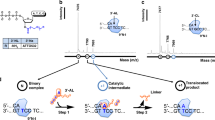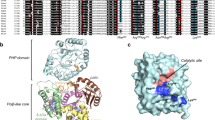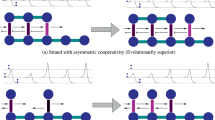Abstract
DNAs from both prokaryotic1–4 and eukaryotic5–8 organisms have yielded restriction fragments which manifest markedly anomalous electrophoretic behaviour (reduced mobility) when run on polyacrylamide gels. We have shown previously9 that the abnormal electrophoretic behaviour of one such fragment is a consequence of stable curvature of the helix axis in solution. The molecules involved tend to contain oligo(dA)–oligo(dT) runs which are approximately in-phase with the helix repeat7,8,10; however, the precise structural elements responsible for DNA curvature have not been identified. One popular model11,12 for curvature invokes a non-coplanar ‘wedge-like’ conformation of ApA/TpT dinucleotide pairs. Despite a lack of direct evidence in support of this model, it has been used to provide quantitative estimates of curvature4,13,14. To critically evaluate the ApA wedge model, we have performed an electrophoretic analysis of a series of closely related DNA polymers in which oligo(dA)–oligo(dT) runs of different polarity were compared. We conclude that ApA dinucleotide wedges cannot account for DNA curvature. Therefore, quantitative estimates for ApA wedge deformations, based solely on apparent curvature, cannot be correct.
This is a preview of subscription content, access via your institution
Access options
Subscribe to this journal
Receive 51 print issues and online access
$199.00 per year
only $3.90 per issue
Buy this article
- Purchase on Springer Link
- Instant access to full article PDF
Prices may be subject to local taxes which are calculated during checkout
Similar content being viewed by others
References
Ross, W., Shulman, M. & Landy, A. J. molec. Biol. 156, 505–529 (1982).
Stellwagen, N. C. Biochemistry 22, 6186–6193 (1983).
Bossi, L. & Smith, D. M. Cell 39, 643–652 (1984).
Zahn, K. & Blattner, F. R. Nature 317, 451–453 (1985).
Simpson, L. Proc. natn. Acad. Sci. U.S.A. 76, 1585–1588 (1979).
Challberg, S. S. & England, P. T. J. molec. Biol. 138, 447–472 (1980).
Kidane, G. Z., Hughes, D. & Simpson, L. Gene 27, 265–277 (1984).
Wu, H.-M. & Crothers, D. M. Nature 308, 509–513 (1984).
Hagerman, P. J. Proc. natn. Acad. Sci. U.S.A. 81, 4632–4636 (1984).
Hagerman, P. J. Biochemistry 24, 7033–7037 (1985).
Trifonov, E. N. & Sussman, J. L. Proc. natn. Acad. Sci. U.S.A. 77, 3816–3820 (1980).
Marini, J. C., Levene, S. D., Crothers, D. M. & Englund, P. T. Proc. natn. Acad. Sci. U.S.A. 79, 7664–7668 (1982).
Levene, S. D. & Crothers, D. M. J. biomolec. Struct. Dyn. 1, 429–435 (1983).
Ulanovsky, L., Bodner, M., Trifonov, E. N. & Choder, M. Proc. natn. Acad. Sci. U.S.A. 83, 862–866 (1986).
Caruthers, M. H. et al. Cold Spring Harb. Symp. quant. Biol. 47, 411–418 (1982).
Sproat, B. S. & Gait, M. J. in Oligonucleotide Synthesis, A Practical Approach (ed. Gait, M. J.) 83–114 (IRL, Washington, DC, 1984).
Maxam, A. M. & Gilbert, W. Meth. Enzym. 65, 499–560 (1980).
Author information
Authors and Affiliations
Rights and permissions
About this article
Cite this article
Hagerman, P. Sequence-directed curvature of DNA. Nature 321, 449–450 (1986). https://doi.org/10.1038/321449a0
Received:
Accepted:
Issue Date:
DOI: https://doi.org/10.1038/321449a0
This article is cited by
-
Reduced intrinsic DNA curvature leads to increased mutation rate
Genome Biology (2018)
-
3DNA: a versatile, integrated software system for the analysis, rebuilding and visualization of three-dimensional nucleic-acid structures
Nature Protocols (2008)
-
Anisotropic elastic bending models of DNA
Journal of Biological Physics (1996)
-
Hoechst 33258, distamycin A, and high mobility group protein I (HMG-I) compete for binding to mouse satellite DNA
Chromosoma (1992)
Comments
By submitting a comment you agree to abide by our Terms and Community Guidelines. If you find something abusive or that does not comply with our terms or guidelines please flag it as inappropriate.



